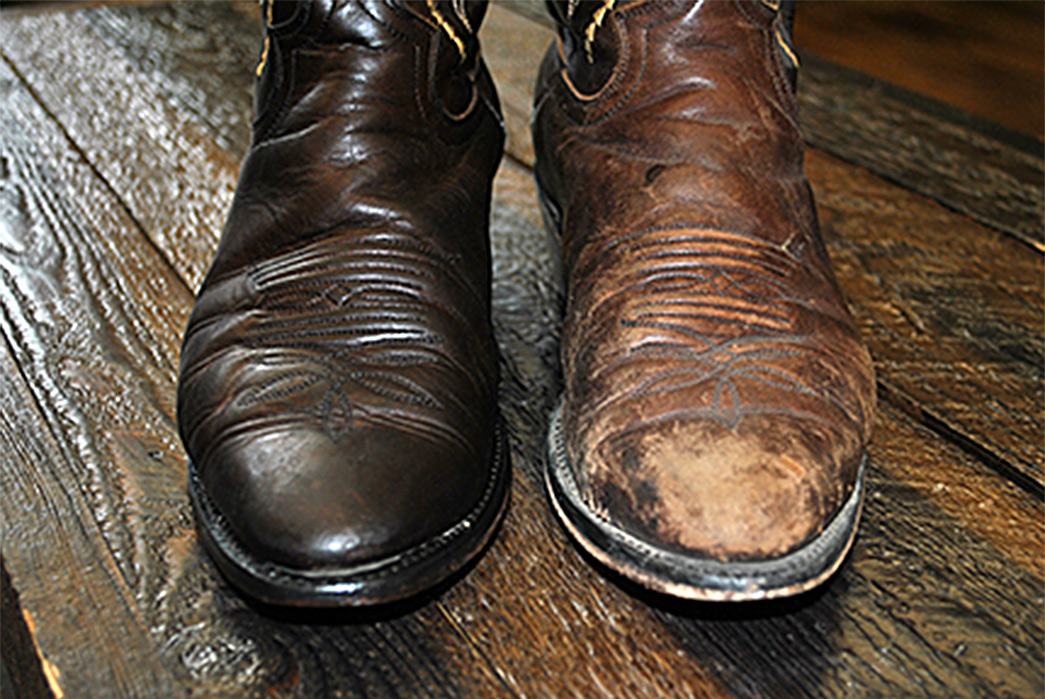
This trick helps relax the fibers of the leather. Make sure your tongues and gussets are straight.

Use a spray bottle to lightly mist the inside of genuine leather boots with a combination of half rubbing alcohol and half water.
Breaking in new boots. The most important piece to breaking in a pair of new leather boots comes before youve even purchased them. Its imperative that you get the sizing absolutely correct before you begin the break-in process. When you get a new boot on your foot it should feel stiff but still good.
If a shoe feels like a leather foot prison dont kid yourselfthat wont change. When making a major investment like. You can also try mink oil to break into your new leather boots.
Just take a pack of mink oil it is a grease-like thick paste heat a bit with a dryer to make it running liquid. Now take a piece of cloth dab into the mink oil and apply to the whole leather area of the boot. Make sure you cover the shoes with a thick layer of the oil.
Now further melt this oil with dryer so as it seeps perfectly into the leather pores. BREAKING IN NEW BOOTS Tips and Practices The Boot Guy Reviews Email. Wear the new boots in the morning when the weather is cooler and your feet are rested.
By around noon your feet start to swell and sweat causing frictionand ultimately blisters. Looking to break in work boots quickly. Breaking in a new work boot takes time and patience.
If you rush the process with home techniques involving extreme water and heat you risk permanently damaging them. Instead lace up your work boots at home. Walk sit and do whatever else you might do normally at home with your new work boots on.
Start with just 10 minutes a day and gradually increase the. What Is Actually Happening When You Break In Fire Boots. Break-in is a process where your new pair of firefighter or work boots are adjusting to your feet.
There are three aspects to it. First the heel and the upper are going to bend and wear in certain spots due to the leather being stretched in key areas where it has not previously stretched. This is because there is not a foot in the boot.
Breaking in new boots is the essential first step to make sure they fit well. The most important thing about breaking in boots is finding ones that fit properly before you walk a hundred yards in them. They should fit well with zero pinching or discomfort when laced up tight.
Weve been busy hitting the phones seeking sponsors and hitting the streets to break in these new hiking boots. Weve got big goals and just need to keep put. Breaking in new riding boots is never fun.
The idea of owning pristine boots all shiny and jet black or brown if you so choose is more romantic than the reality of how hard new riding boots are to squeeze onto your calf and zip all the way up. If you can successfully get your new riding boots on then theres the painful breaking in process. Put your new boots on and walk to the kitchen and back a few times and note the places where they rub its likely to be heels the smallest and largest toe and the sides of the foot that bump out just a little about where the little and big toes join the foot.
Put padded blister plasters on. Use a spray bottle to lightly mist the inside of genuine leather boots with a combination of half rubbing alcohol and half water. This trick helps relax the fibers of the leather.
Wear your boots indoors as much as you possibly can. No matter how silly it looks every minute you spend in your new kicks helps speed up the break-in process. Breaking in is a term used to describe the process of wearing new boots so they mould to your feet.
The process will also soften up the material of the boots so that they dont rub your feet uncomfortably. Breaking in your boots is the best way to ensure that they dont cause discomfort when out. How you can break in new boots and shoes.
Make sure your tongues and gussets are straight. Your new boots will be a little stiff at first which is fine. Walk around the block and around town.
Make sure your boots feel good at each stage before upping the distance. Put on a daypack and hit the trail. Off pavement is where serious breaking in happens.
Be sure you gradually increase both weight and mileage throughout this phase.